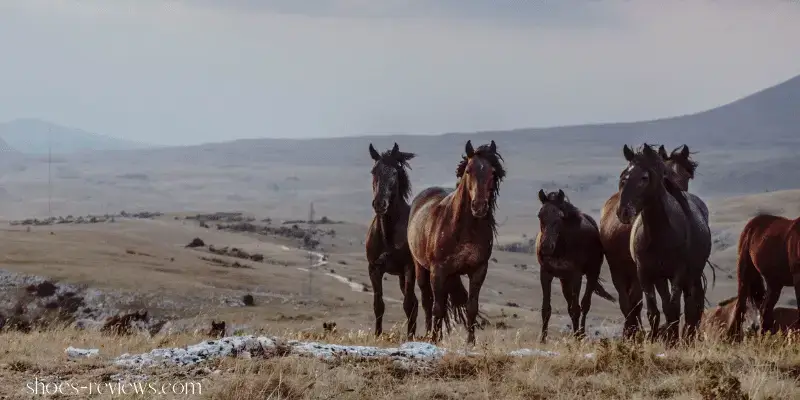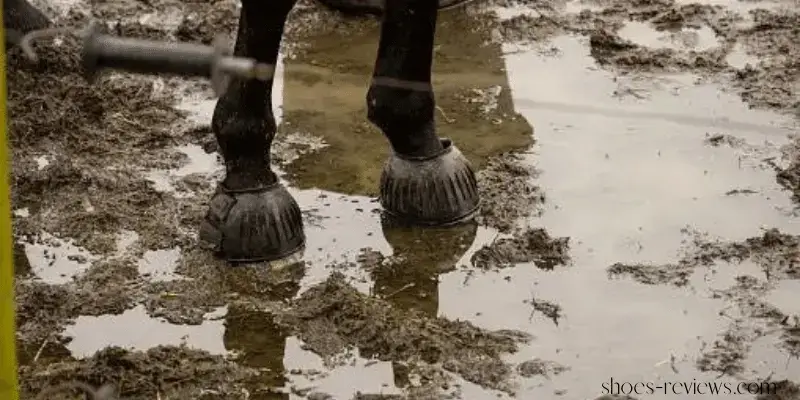Why do wild horses move over large areas without worrying? With their feet hitting the ground gracefully and firmly? It’s hard to believe that these beautiful animals. Don’t wear shoes like domesticated animals do.
As we mentioned: Why Do Wild Horses Not Need Shoes? The answer lies in how well they have adapted to their natural environment.
How do they get through rough terrain, bad weather, and healthy hooves without help? Find out why wild horses don’t wear shoes and what we can learn about freedom and movement from this natural thing—and being able to take care of ourselves.
An Overview Of Wild Horses
Wild horses that are on their own don’t need people. Beautiful animals are in danger of dying out. Wild horses fear being without a home. Due to development, there are fewer places for wild horses to live.
Disease and loss are caused by inbreeding and genetic differences. Wild horses can be caught and moved by the government. Each year, the BLM rounds up hundreds of wild horses so US government land doesn’t get too much grass.
Many people think the arrest was good news for farmers who didn’t want to share grazing rights. The BLM kills wild horses, even though it promised not to do so in 1971.
Wild horses need to be protected because their numbers are going down. Stay away from companies that want to kill these beautiful species. The HSUS and IFAW work to protect wild horses and the places they live.
Why Do Wild Horses Not Need Shoes

Wild horses don’t need shoes for more than one reason. One reason is that their feet are solid. That is strong enough to survive in their complex surroundings.
They can also spread their weight over their four legs, keeping their feet from hurting. Wild horses live in groups called “herds,” which keeps them safe from attackers. Makes sure they have food and drink.
And, of course, a wild horse’s feet are made for the area where it lives—letting them move and get around on the rough ground.
The Natural Structures And Physiology Of Wild Horse Feet

Wild horses’ feet change to fit the ground they live on. Horses put their weight on their hoof walls, which protect their organs. Keratin, a tough protein found in hair and nails, is used to make the walls of a hoof.
Laminae connect soft tissues to the wall of the hoof. The laminae are layers of elastic tissue that run from the coronary band (the border on the foot) to the hoof wall.
Small blood vessels and nerves bring blood to and feel structures in the hoof called laminae. The base of the leg is the most profound. The solid sole covers the tender parts of the hoof.
The frog is a springy cushion shaped like a V that sits between the two parts of the hoof wall. Frogs can handle stress and give you a grip on soft or uneven ground. Wild horses don’t need shoes to protect or grip their natural feet.
Why Don’t Wild Horses Need To Have Their Feet Cut?
There are several reasons why wild horses don’t need their feet clipped. One reason is that they live in open areas with much room to move, which wears down their feet.
Another reason is that they eat a lot of roughage, which helps keep their feet in good shape. Wild horses don’t stay still for long, which helps keep their feet healthy. Wild horses keep their claws in good condition by moving around and wearing down their nails.
The Role Of Nutrition In Wild Horse Hoof Health
The horse’s foot is an engineering marvel that covers sensitive organs and can take massive hits. A robust, flexible hoof has well-developed blood vessels, nerves, and connective tissue.
Most problems with the feet of wild horses are caused by bad food. Lack of nutrients makes thin, fragile feet more likely to break. Poor nutrition can change a horse’s digestion and cause foot problems.
Wild horses can be fed in different ways to keep their hooves healthy. Having fresh grass is one of the best things you can do. If the range is not available, feed hay or haylage. The horses must always have clean water.
Wild horses need good food and foot care to keep their legs in good shape. Provide the required trimmings and shoeing. Your horse’s doctor or trainer can tell you how often to care for them based on their needs.
Common Diseases And Disorders That Can Affect The Hooves Of Wild Horses
Many common diseases and illnesses can hurt wild horse feet. Laminitis, an infection of the foot’s soft tissues, is common. It could be caused by overeating food or standing on hard surfaces. Other common problems include:
- Abscesses are infections that occur when bacteria get trapped inside the hoof.
- The founder condition results when the horse’s weight is distributed on its feet.
Parasites can live inside and on the outside of wild horses. These could cause anything from mild irritation to significant health problems.
See a vet immediately if you notice changes in your horse’s hooves. Most problems with feet can be fixed without causing lasting damage if care is taken.
Do Overgrown Hooves, Hurt?

Horses can feel pain from feet that are too long if the feet aren’t kept in good shape. They can get too long and start to curl under, which puts pressure on the horse’s foot and can hurt it.
Also, if the hooves aren’t clipped, the pressure on the horse’s foot can be uneven, which can be painful. Horses with feet that are too long may have to walk, which can also be painful and uncomfortable.
Benefits for Wild Horses of Not Wearing Shoes
There are many perks to wild horses not wearing shoes. One advantage is that they have a better grip and can go faster. Another benefit is that they are less likely to get hurt because their feet are more flexible.
Also, wild horses’ feet are more potent than tame horses. So they don’t need the extra protection that shoes give.
How to Care for Your Own Horse’s Feet Without Shoes
It is essential to know that horses have evolved to live and move on soft, uneven ground. Here are some tips on how to care for your horse’s feet without shoes:
1. Check your horse’s hooves for cracks, chips, or other damage. It must be if your horse spends much time on hard ground or concrete.
2. Use a hoof pick to remove any dirt or debris from the hoof. It will help prevent infection and keep the foot healthy.
3. Use a hoof brush to clean the hoof after picking it out. That will help remove dirt and debris and keep the foot clean and healthy.
4. Trim your horse’s hooves. It will help prevent overgrowth and keep the hoof shape correct. If you need help with how to trim your horse’s feet, ask a farrier or veterinary professional for help.
5. Keep your horse’s stall clean and free of debris. A clean stall will help prevent infections and keeps the horse’s feet healthy.
6. Make sure your horse has access to plenty of fresh water.
Conclusion
Wild horses have lived in the same place for thousands of years, and their feet have become rigid. They don’t need shoes because their strong feet protect them from rough, sandy ground. Understanding why wild horses don’t need shoes helps us. Learn about nature and respect its power.